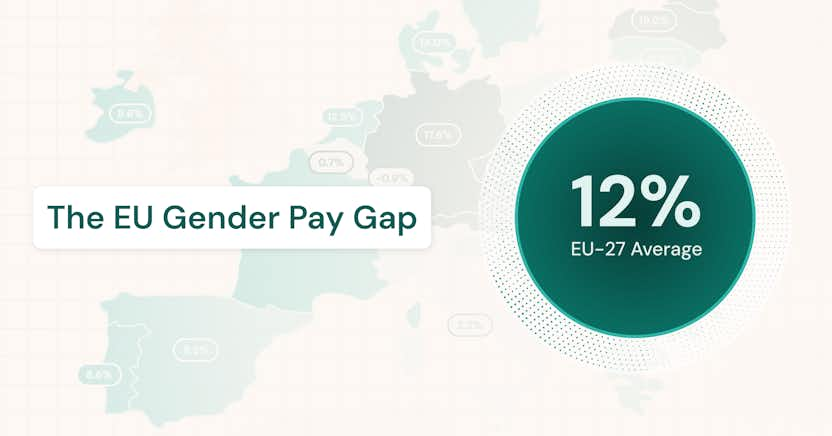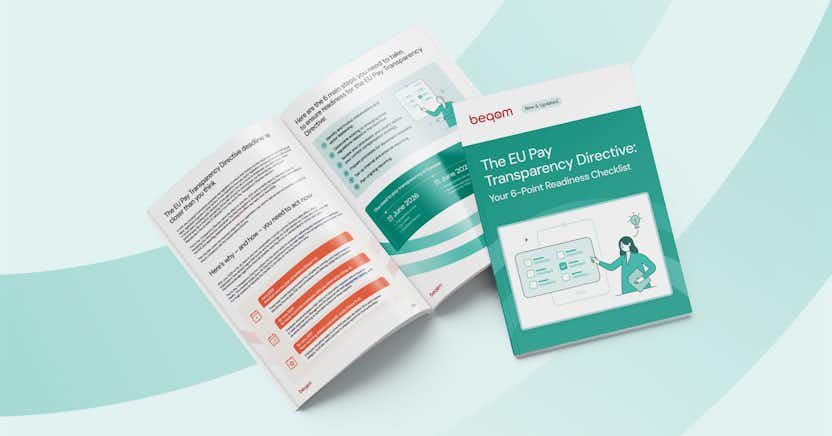Are You Using Pay Equity Strategically?

Learn more about the following beqom products
As pay equity comes to the forefront because of new regulations around the world, there is a tendency to think of it as an imposed legal requirement. It’s true, it’s no longer optional. But the fact is, pay equity and transparency have emerged as pivotal factors in organizational success.
Why has pay equity become not just important but strategic? And, how can you leverage it to help deliver on your company’s objectives?
The increasing relevance of pay equity
In recent years, the spotlight on pay equity has intensified as new regulations have emerged in the EU, US, and globally, and as organizations recognize its multifaceted impact. While compliance with the law is important (a necessity, in fact), pay equity has taken on a larger significance than just checking regulatory boxes. The same societal pressures that led to regulation have also made equal pay a strategic imperative for companies aiming to thrive in today's competitive economy.
The pressing question for HR executives is no longer whether pay equity should be addressed, but how it can be strategically integrated to support broader organizational goals.
Positioning pay equity as a strategic lever
At its core, pay equity is not just about fair compensation; it is a potent driver of competitiveness in two key areas:
Building a top-tier, high-performance workforce. On the one hand, fair pay helps talent efforts, as it contributes significantly to employee satisfaction, engagement, and productivity. As HR teams grapple with the challenges of recruitment and retention, pay equity emerges as a key differentiator, attracting top talent and fostering a positive company culture.
Winning over customers and investors. At the same time, in an age of increasing consumer focus on a company’s values and reputation, having a positive reputation can play favorably with both customers and investors, helping both the top line and market capitalization.
Understanding the global context
Navigating the intricacies of pay equity is essential for businesses operating on both sides of the Atlantic. In the United States and Europe, as well as globally, local regulations and cultural nuances vary. HR executives must comprehend the landscape in each of their operating regions to implement effective and compliant pay equity strategies that address the unique challenges and opportunities each region represents.
Why pay equity matters strategically
As employers increasingly recognize the strategic importance of pay equity, it is crucial to understand the tangible benefits that extend beyond compliance.
Research by Josh Bersin found that companies effective in pay equity are:
- 1.6 times more likely to meet or exceed financial targets
- 2.1 times more likely to attract the talent they need, and
- 1.7 times more likely to innovate effectively.
If done right, pay equity can be a transformative force in the pursuit of growth and success.
Improved employee satisfaction, retention, and productivity
Pay equity is a cornerstone of employee satisfaction. When employees perceive that their contributions are fairly compensated, it fosters a sense of value and recognition. This satisfaction, in turn, becomes a powerful driver for employee retention as well as productivity. High levels of satisfaction and low turnover contribute to a stable and committed workforce, providing a competitive advantage in talent acquisition. Conversely, wage disparities can fuel resentment and disengagement, eroding the foundation of a harmonious and high-performing workplace.
Enhanced reputation and employer branding
In an era of heightened social consciousness and equality for women, companies are under increased scrutiny for their equal pay practices. Demonstrating a commitment to pay equity is not just a legal requirement; it is a strategic move to enhance corporate reputation and support recruiting efforts. Firms known for fair and equitable compensation are more likely to attract the workers they want and enjoy positive word-of-mouth, bolstering their employer brand. However your employees feel about the pay at your company, the world (and your applicant pool) will know about it, thanks to crowdsourced review sites like Glassdoor and Comparably.
Mitigation of legal risks and compliance advantages
Proactively working to eliminate pay gaps mitigates legal risks and positions the organization as a responsible corporate citizen. Legal compliance is a shield against potential lawsuits and regulatory penalties. These are no joke: in 2022 Google paid $118 million to settle a discrimination class action lawsuit. Beyond avoiding legal troubles, compliance with pay equity laws and regulations positions the organization as a leader in ethical business practices.
Positive impact on diversity and inclusion initiatives
Pay equity is intrinsically linked to diversity and inclusion. Pay is one way that companies put their money where their values are. By ensuring equitable compensation, organizations create an environment where all employees, regardless of gender, race, or background, feel valued and included. This alignment with diversity and inclusion initiatives not only meets societal expectations but also contributes to a diverse and innovative workforce, fostering creativity and adaptability.
Aligning pay equity with corporate priorities
Strategic HR executives understand that pay equity is not a standalone initiative but a key component of broader corporate strategies. By aligning pay equity goals with overarching business objectives, organizations can ensure that compensation practices support and reinforce the desired company culture, values, and long-term growth strategies. Whatever the goal, when compensation practices are perceived as fair, employees are more likely to be motivated, engaged, and aligned with the company's broader goals.
Pay equity as a competitive advantage
As businesses strive to distinguish themselves in a competitive environment, pay equity emerges not only as a moral imperative but as a strategic differentiator. Businesses can leverage pay equity to gain a competitive edge and align with broader corporate strategies for growth and talent acquisition. By exploring how pay equity can be a competitive differentiator, organizations can move beyond the notion of compliance and transform pay equity into a strategic asset.
So what are some practical steps HR executives can take to use pay equity as a strategic driver? What role does technology play in this transformative journey?.
Implementing Pay Equity as a Strategic Initiative
Strategically implementing pay equity requires a systematic approach that goes beyond addressing immediate concerns. This section outlines the essential steps HR executives can take to integrate pay equity seamlessly into their organizational framework, emphasizing the importance of clear policies, effective communication, and the strategic use of technology.
Clarify your overall business strategy
Some companies want to start by implementing a pay equity audit. But before that, it’s important as a first step to consider your company’s philosophy, people strategy, and business objectives. What values are important to us? What kind of employee experience do we want? What are we trying to accomplish as a company? Consider also what pay equity is worth to you, and what your budget is for investing in the necessary tools and expertise, as well as your budget for remediation of pay inequities.
Assessing the current state: conducting a pay equity audit
Before embarking on a pay equity journey, organizations must conduct a thorough assessment of their current compensation landscape. This includes evaluating existing pay structures, identifying potential disparities in salaries and other forms of compensation, and understanding the factors that contribute to them. This means not just calculating the unadjusted gap between what men and women earn, but looking across multiple demographic factors, and controlling for explanatory factors (role, education, skills, etc.) to determine the adjusted, or unexplained gaps. A comprehensive pay equity audit serves as the foundation for informed decision-making and strategic planning.
Developing clear pay equity policies and guidelines
Clarity and transparency are key when it comes to pay equity. HR executives should work collaboratively with leadership to establish clear and comprehensive pay equity policies and guidelines. These documents should articulate the organization's commitment to fairness, outline the criteria for compensation decisions, and provide a transparent framework for addressing wage disparities.
Communicating pay equity initiatives to employees and stakeholders
Effective communication is vital to the success of any pay equity initiative. HR executives should craft a communication strategy that not only informs employees about the company’s commitment to pay equity but also educates them on the process and criteria for compensation decisions. Transparency fosters trust and engagement, key elements in the successful implementation of pay equity.
Making the right investments
In the digital age, technology plays a pivotal role in implementing and sustaining pay equity. HR executives should explore and invest in comprehensive compensation, performance, and pay equity software. These tools streamline data analysis, identify pay disparities, facilitate the implementation of equitable compensation structures, and help provide insight into the causes of inequities. See the section below on technology considerations.
Ensuring fairness in compensation decision-making processes
Pay equity is not a one-time fix but an ongoing commitment to fairness. HR executives must embed pay equity principles into the organization's compensation decision-making processes. This includes regular reviews, continuous monitoring of pay structures, and addressing any identified disparities promptly and equitably.
Key technologies to support pay equity
Like anything else in HR today, the right enabling technology is key to delivering results efficiently and effectively. For supporting pay equity, technology solutions for pay equity, compensation, and performance management are key.
Features and capabilities needed in pay equity technology
A pay equity solution should provide robust features such as advanced analytics, regression analysis, scenario modeling, and reporting capabilities. Pay equity software can work with your pay bands and measure gender and other demographic discrepancies in pay such as race, age, or ethnicity, and offer recommendations on how to proactively close pay gaps.
Integration with compensation management
The compensation management system plays an important role in delivering pay equity. Compensation modeling can optimize the budget impact for various pay equity remediation scenarios. When pay equity is embedded into real-time daily compensation processes, managers have support for making data-driven pay decisions for new hires, salary merit increases, and promotions, that are aligned with pay equity objectives.
Linking pay equity with performance management
Solving pay equity requires more than just adjusting salaries to eliminate the adjusted pay gap. The unadjusted gap may signal deeper problems, like imbalances in hiring, promotions, goals, or career development. Data from the performance system can help to understand and address root causes, by analyzing feedback, goals, or evaluations.
Solid planning and the transformative power of technology can help you realize the full potential of pay equity within your organization.
Overcoming challenges in pay equity adoption
While the benefits of pay equity are clear, the journey to strategic implementation is not without its challenges. Research by Josh Bersin found that while 71% of companies consider it a critical component of their people and business strategy, an astounding 95% of companies struggle with pay equity. While new regulations are pushing companies to address pay transparency and equity, it is often done piecemeal rather than holistically.
HR leaders need to be prepared to overcome resistance, navigate cultural shifts, and build the necessary skills and awareness to champion pay equity effectively.
Addressing resistance and navigating cultural shifts
Resistance to change is natural, and the adoption of pay equity may face pushback from various quarters within an organization. HR executives should proactively identify sources of resistance, whether from leadership, middle management, or employees, and implement targeted strategies to address concerns. Effectively communicating the rationale behind pay equity and framing it as a strategic imperative can help ease resistance.
Cultural shifts are integral to the successful adoption of pay equity. HR executives must foster a culture that values transparency, equality, and fairness. This cultural transformation requires leadership commitment, clear communication, and the establishment of new norms that prioritize pay equity as a core value.
As Bersin says, fair pay is not a one time fix, it’s a new way of thinking about pay and pay practices. It is systemic — it’s not a pay problem, it’s an overall people and business problem. As such, change management and communication are important. You have to do the analytics, but you also have to tell people that you are fixing inequities, and train managers on how to have these conversations.
Providing training and resources for HR teams
HR teams are at the forefront of implementing pay equity initiatives. Equipping HR professionals with the necessary knowledge and skills is paramount. Training programs should cover the fundamentals of pay equity, legal considerations, the use of technology tools, and effective communication strategies. Ongoing education ensures that HR teams stay abreast of evolving best practices and are well-prepared to navigate complexities.
Utilizing data and analytics for continuous improvement
Data is a powerful ally in the journey toward pay equity. HR executives should leverage data and analytics to continually assess and refine pay equity initiatives. Regular audits, analysis of compensation data, and tracking key performance indicators (KPIs) allow organizations to identify trends, address emerging disparities, and demonstrate a commitment to continuous improvement.
By acknowledging and addressing these challenges head-on, businesses can pave the way for a smoother transition to strategic pay equity. The subsequent sections will delve into the development of a roadmap for strategic pay equity, encompassing the establishment of key performance indicators, continuous monitoring, and collaboration with external experts.
The roadmap to strategic pay equity
Embarking on the journey to strategic pay equity requires a well-defined roadmap that guides HR executives through key milestones. Earlier we talked about defining your overall philosophy and business objectives to provide the context for addressing pay equity. In this section, we outline the essential steps to establish and sustain pay equity as a strategic initiative, emphasizing the importance of key performance indicators (KPIs), continuous monitoring, and collaboration with external experts.
Establishing key performance indicators (KPIs) for pay equity
Measuring the success of pay equity initiatives requires the establishment of clear and measurable KPIs. These indicators should go beyond mere compliance metrics and align with broader strategic goals. Examples of relevant KPIs include the reduction of gender pay gaps, improvements in employee satisfaction related to compensation, and the overall alignment of pay structures with performance and market benchmarks.
Make strategic technology investments
Great ideas are not enough, you need the tools that can make your plans a reality. Evaluate technology solutions carefully, and consider that best of breed solutions are likely to deliver the most satisfying results. Keep in mind that pay equity software is most powerful when aligned with your compensation and performance management systems, to provide a comprehensive and data-driven approach to address pay equity. Look for deep pay equity expertise coupled with feature-rich solutions in the companies you choose to partner with.
Continuous monitoring and adjustment of pay equity strategies
Pay equity is not a one-and-done endeavor but a continuous process that demands vigilance. HR executives should implement regular monitoring mechanisms to track progress against established KPIs. Continuous monitoring serves to identify emerging issues, assess the impact of policy changes, and adjust strategies accordingly. It also signals a commitment to ongoing improvement and responsiveness to change.
Seeking external expertise and collaborating with industry peers
Collaboration with external experts and industry peers can provide valuable insights and guidance. External consultants specializing in pay equity can offer a fresh perspective, conduct independent audits, and ensure that the organization remains at the forefront of best practices. Collaboration with industry peers through forums, conferences, or professional networks facilitates knowledge exchange and allows organizations to benchmark their pay equity strategies against industry standards.
By diligently following this roadmap, organizations can transform pay equity from a compliance necessity into a dynamic and strategic force that accelerates business success.
A call to action: embracing the transformative potential of pay equity
From enhancing employee satisfaction and retention to fortifying organizational reputation and competitiveness, pay equity aligns with broader corporate strategies, shaping a workplace where talent thrives, innovation flourishes, and success becomes sustainable.
The journey toward strategic pay equity is not without challenges, but it is a journey worth undertaking. HR executives are urged to view pay equity not merely as a legal requirement but as a strategic imperative—one that has the power to elevate the organization to new heights.
We encourage you to embrace the transformative potential of pay equity and witness the positive effects it can create within your organization and beyond. Contact us at beqom to speak with a pay equity expert and start your pay equity journey on the right foot.
Learn to take a strategic approach to pay equity.The Pay Equity Playbook.








